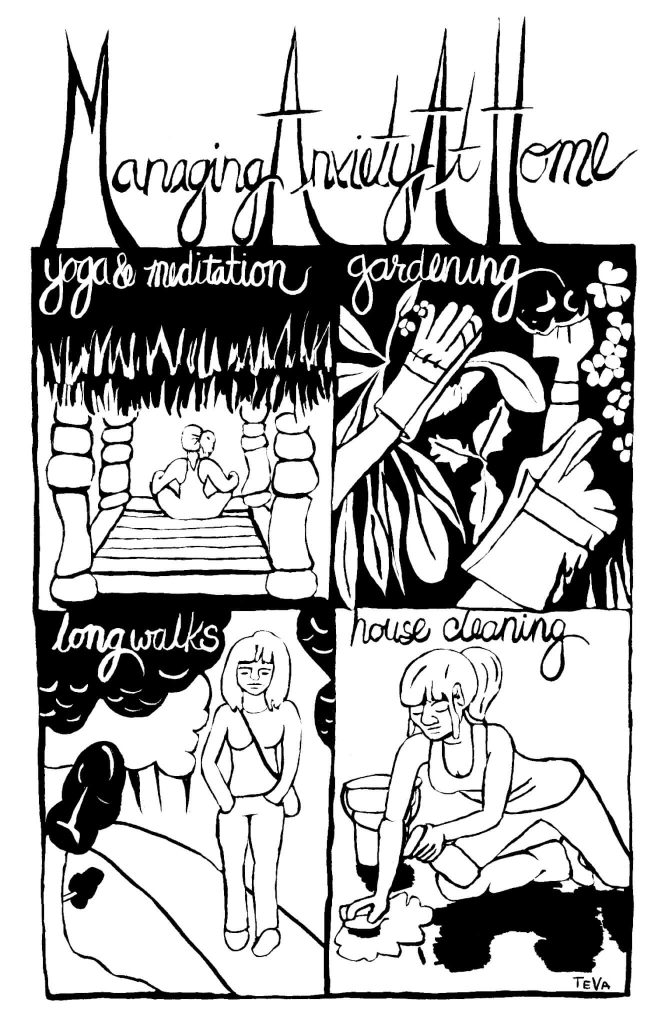Post by HLTD50 student Kris

Teva Harrison’s “Managing Anxiety at Home” (2018), one of a series of 37 comics published in The Walrus.
In my investigative work as a health humanities student, I have witnessed countless representations of illness that have inspired my thinking. Using Arthur Frank’s teachings (click the “Arthur Frank” tag below or click here, here, or here for other summaries of Frank’s work on this blog) in order to begin to categorize and understand these illness experiences has been helpful beyond compare. However, in looking at these stories of overcoming and redefining illness, I must admit something: I can seldom relate. Although I have been acutely ill, and I anticipate chronic illness in the future, common stories of cancer, disability, and operating rooms have never been applicable to me, living as an “average,” that is non-chronically-ill, person.
My experiences of illness have been predominantly mental rather than physical. And more often than not, the portrayals of mental illness I see are chaotic (see: David Foster Wallace’s short story The Depressed Person, or Alex Boya’s short film “Focus”). I sought a narrative that could provide some degree of counsel for my everyday life – a good feature of any story, says Frank.
I then did a close reading of Arthur Frank’s Afterword in The Wounded Storyteller, in which he works with Jonathan Lear’s concept of “radical hope” to assert “Five Criteria of Courage”: a set of guidelines which allow an ill person to construct a new routine based on the hope that a life lived with illness can be virtuous and excellent. I found these criteria to be very applicable to the daily experience of existence in general, not only illness.
I found unexpected counsel in Toronto-based graphic artist Teva Harrison’s comic series about living with metastatic cancer (published as an award-winning book, In-between Days: A Memoir About Living With Cancer, by Anansi Press in 2016). Harrison focuses less on the clinical aspect of her treatment progression, and more on the things she does to get through the day. Perhaps unknowingly, Teva follows Frank’s five criteria almost exactly and provides her readers with a framework for coping not only with physical disease, but mental illness as well. I will unpack the ways in which Teva accomplishes this, in hopes that her mechanisms can provide counsel to anyone reading this post.
*
Criterion #1:” Reorient [one]self to what was genuinely shameful – and to teach others”
In her comic “The ‘Big Change,’” Teva shares the various symptoms of early menopause caused by surgery required for treatment: hot flashes, cold sweats, thinning hair, and vaginismus, among others. These are symptoms which make Teva feel shameful, especially as she is only in her 30’s. She distances herself from this shame by changing her understanding of the symptoms: “they don’t tell you how surgical menopause is actually the worst (…) but get this: it’s the worst for my cancer too, and I like to make it suffer” (Harrison, 2015). Teva then teaches others by creating and disseminating these comics. She has compiled them into a book called In Between Days.
Criterion #2: ‘The formulation of “an ideal in terms of which [one] could aim for something fine”
When one becomes ill in any way, their standards of what a “good day” is will change. In “Managing Anxiety at Home,” Harrison shares what she does to keep sane and to keep her anxiety at bay. These activities include “yoga & meditation, gardening, long walks,” and “house cleaning.” While these may once have been mundane activities to Harrison, they are now routines that she relies on during a stage in her life when she does not have much control. Just being able to complete these activities is “fine” (definition: an impressive delicacy) to Teva.
Criterion #3: “Developing good judgment, and making decisions of how to act that are based on knowledge”
People are incredibly complex. We all have our own individual system of values and beliefs. However, these beliefs become challenged when we are ill, and we must rely on objective knowledge at times in order to make a decision. In “Animal Testing Y/N,” Harrison, a long-time vegetarian, shows her tension in deciding whether to taking medicine that has been testing on animals. Although her values are tested, she exercises her judgment in order to make the most logical choice that will progress her treatment.
Criterion #4: “Willingness to risk”
Being ill requires risks, says Frank, one literal risk being when one accepts a treatment without certainty that it will be effective, and another when one takes the narrative risk of reshaping their life in the face of illness. Harrison, who shares that she has a lust for life, must trade in her consciousness temporarily in exchange for painkillers that are effective. Her risk in this situation is not that her treatment will be ineffective, but that she may lose the happy life she is used to in order to simply survive. This is a valiant demonstration of courage.
Criterion #5: ‘[Do not] engage in “mere wish-fulfilling optimism”’
Frank rejects the idea that hope in the context of illness should be a hope to return to your original state, or a wish for any one specific outcome. Frank speaks of intransitive hope, hope which has no specific objective, but leaves the future open to be imagined and reimagined. Harrison begins to understand that she can never wish to return to her original state, but she can reimagine her future. In the comic “Incurable,” she depicts herself as a falcon soaring across the sky. She captions the comic with “What do I have to lose?” In this way, she reimagines herself, not denying the fact that she is incurable. Harrison braces herself for what is to come and chooses an optimistic reimagining of her identity, because she has nothing else to lose.